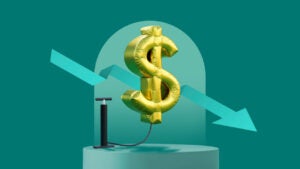Top high-yield savings accounts are still beating inflation. Here’s why that’s important

Key takeaways
- High-yield savings accounts can help protect your money’s purchasing power by earning returns that outpace inflation.
- Shopping around for competitive yields, particularly at online banks, can earn you several times more interest than traditional bank accounts.
- The difference between high-yield and low-yield accounts can amount to hundreds of dollars annually in earned interest, even on modest balances.
Personal finance fact: Your money loses purchasing power over time, especially if it’s in a savings account that isn’t earning interest. But there’s good news for savers: top savings yields can outpace inflation when you choose the right account.
How does inflation affect savings?
Money that doesn’t keep up with inflation is losing purchasing power – it’s that simple. This effect impacts every dollar in your savings account, whether you’re saving for short-term goals or long-term security.
Consider this practical example: If you spent $20 at a restaurant five years ago, you might need $25 or more to buy the same meal today. This means that without earning interest that at least matches inflation, your savings gradually buy less and less over time.
That’s how inflation affects your savings. Having that money in a high-yield savings account paying a competitive yield would keep up with inflation better than the money that would merely sit in your home not working for you.
5 reasons why keeping up with inflation matters
Earning an APY that’s not only keeping up with inflation, but that’s surpassing it, helps maximize your savings at a time when prices remain elevated on various goods and services. This, ultimately, gives you the ability to afford more of the things you want and need.
Here are five reasons why keeping up with inflation matters.
1. Protecting your dollar’s future value
The fundamental truth of inflation is that a dollar today won’t buy as much as it will in the future. Here’s why this matters:
- Money sitting idle loses value every year
- Price increases compound over time
- Even low inflation rates can significantly impact purchasing power over decades
- Without growth, your savings effectively shrink in real terms
“If I have my money earning money at some percentage — even if it’s not exactly the same as inflation — and if I’m maximizing my savings, I get closer to meeting my inflation needs when inflationary periods hit,” says Jill Schlesinger, certified financial planner and business analyst for CBS News.
2. The opportunity to outpace rising prices
With high-yield savings accounts, you have a real opportunity to beat inflation. This wasn’t always possible – historically, periods of high inflation made it challenging for any savings account to keep pace. But in today’s market, top-yielding accounts can often surpass the inflation rate.
A critical note: If you’re banking with a major brick-and-mortar institution, you’re likely falling behind inflation. Many of the biggest banks pay minimal interest, often well below the national average rate.
3. Retirement planning
No matter whether you’re many years from retirement or are already retired, you need to keep up with inflation during retirement because you’ll likely be earning less. And your top earning years are likely behind you.
“If you’re planning for retirement, and you are planning to say, ‘OK, I can live on $5,000 today,’ Well if $5,000 today is … not the same amount of money as $5,000 ten years from now, you’ll need more money,” Schlesinger says. “So your money that you have has to grow faster than the rate of inflation to simply meet the needs that you have.”
To illustrate how inflation affects long-term savings, consider these real examples:
- $10,000 from 10 years ago would need significantly more today for equal purchasing power
- $10,000 from 20 years ago would need nearly double today
- $10,000 from 30 years ago would need more than double today
Source of calculations: CPI Inflation Calculator, Bureau of Labor Statistics
4. Persistence of inflation
Understanding that inflation isn’t going away is crucial for financial planning. Financial experts suggest planning for an average inflation rate of at least 3 percent over the long term.
“Essentially, a growing economy will have inflation,” Schlesinger says. “So the reason why the Fed really wants to control inflation is that inflation is quite pernicious. It impacts every single person.”
5. Protection against a “double whammy”
When high inflation combines with market losses, it creates what experts call a “double whammy” – a particularly challenging situation for your finances. While you can’t control market performance, you can work to have your savings outpace inflation to avoid being hit twice in the same year.
Open an online savings account with a competitive yield
To outpace inflation, find the highest-yield savings account, at an FDIC-insured bank, that works for you. You’ll typically find the highest yields at online banks. Look for consistency in APY, because rates on savings accounts are generally variable.
You also want to make sure the account has a minimum opening deposit amount you’re comfortable with and that it doesn’t have any fees that are going to eat away at your competitive yield.
Opening an account online is usually a quick and straightforward process. You’ll be asked for information such as your name, Social Security number, date of birth and street address.
The difference between high-yield and traditional savings accounts can be substantial. For example, $10,000 in a high-yield savings account earning a competitive rate and compounding monthly would earn significantly more in interest after a year than in a traditional account earning minimal interest.
Bottom line
It’s easy to feel good about the money you’ve saved, but the money you have right now won’t be able to buy as much in the future. Your money loses purchasing power when the yield it’s earning doesn’t outpace the rate of inflation. Keeping up with inflation is a marathon, not a sprint. You can make sure you’re keeping up with it by having your savings in a competitive yielding account, which are usually found at online, FDIC-insured banks.







